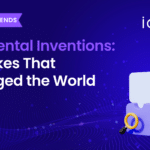
Not every invention started with a well-thought-out plan. In fact, some of the products that we use in our everyday lives and were created out of accidents, curiosity or even frustration. From a failed adhesive that became the Post-it Note to a melted candy bar that led to the microwave oven, history is filled with stories of accidental inventions that changed the world.
In this article we explore 10 discoveries that happened accidentally and the surprising ways they came to be.
Post-it Notes: The Sticky Success Story
Patent No. US 3,691,140:
It all began when 3M scientist Spencer Silver was trying to create a super-strong adhesive. Instead, he accidentally invented a weak, pressure-sensitive adhesive that didn’t stick well—except when applied lightly. Initially dismissed as a failed experiment, Silver’s “mistake” was later transformed into the iconic Post-it Note after his colleague Art Fry needed something to keep bookmarks in his hymn book from falling out. A simple solution led to one of the world’s most ubiquitous office supplies.
Takeaway: Sometimes, a “failure” is just an undiscovered gem in disguise.
X-Rays: An Accidental Peek Into the Body
Patent No. US 1,061,936:
In 1895, German physicist Wilhelm Roentgen was conducting experiments with cathode rays when he noticed a fluorescent glow coming from a nearby fluorescent screen, even though it wasn’t in direct line of sight. Upon further investigation, he realized that he had discovered a new type of radiation, which he named X-rays. Roentgen’s accidental discovery became the foundation of modern medical imaging, revolutionizing diagnostics in the medical field.
Takeaway: Sometimes, scientific curiosity and an unexpected result can change the way we see the world—literally!
Coca-Cola: A Secret Formula That Stuck
Patent No. US 798,395:
In 1886, Dr. John Pemberton, a pharmacist in Atlanta, was trying to create a remedy for headaches and exhaustion. He accidentally created a syrup that, when mixed with carbonated water, became the world-famous beverage known as Coca-Cola. While the formula was originally intended to be medicinal, it quickly became a popular soft drink, creating one of the most recognizable brands in the world.
Takeaway: What starts as a medicinal concoction might end up as a global refreshment.
The Microwave Oven: A Hot Discovery
Patent No. US 2,457,091:
In the 1940s, engineer Percy Spencer was working on radar technology when he noticed that a candy bar in his pocket had melted. Curious, he tested the theory by placing popcorn kernels near a magnetron (a component of radar equipment) and watched them pop. This serendipitous moment led to the development of the microwave oven—a kitchen device that would revolutionize cooking worldwide.
Takeaway: A melted candy bar and a little curiosity sparked a culinary revolution!
Safety Glass: A Shattered Discovery
Patent No. US 1,612,228:
In 1903, French chemist Édouard Bénédictus accidentally dropped a glass flask that had been coated with a plastic film. Instead of shattering into pieces, the glass cracked but remained in one piece. This accident led to the invention of laminated safety glass, which is now used in car windshields, skylights, and more to prevent dangerous glass shattering.
Takeaway: Sometimes, a breakage can lead to a breakthrough that keeps you safer!
The Pacemaker: A Heart-Stopping Accident
Patent No. US 2,992,561:
In 1956, engineer Wilson Greatbatch was attempting to build a heart rhythm recording device when he accidentally used the wrong resistor. This caused the circuit to emit electrical pulses, which mimicked the function of a heart’s natural rhythm. Greatbatch’s “mistake” led to the creation of the implantable pacemaker, a life-saving device that has kept millions of people’s hearts beating for decades.
Takeaway: One tiny mistake in an electrical circuit can turn into a lifesaver!
Superglue: An Adhesive Revolution
Patent No. US 2,768,109:
In 1942, chemist Harry Coover was working on creating clear plastic for gun sights during World War II. However, he accidentally created a sticky substance that bonded almost instantly and couldn’t be removed. Initially discarded as a failed product, it was later repurposed as Superglue, becoming an essential adhesive in countless industries and everyday life.
Takeaway: What may seem like a nuisance (sticking to everything!) can sometimes become the most useful invention.
Potato Chips: A Crunchy Invention
Patent No. US 3,071,137:
In 1853, a chef named George Crum was frustrated by a customer’s complaint about his fried potatoes being too thick. In an attempt to annoy the customer, Crum sliced the potatoes paper-thin, fried them until they were crispy, and seasoned them heavily with salt. The result? A new snack sensation: the potato chip. What started as a “punishment” for picky customers quickly became a snack that changed the culinary world.
Takeaway: A little bit of frustration can lead to a whole lot of flavor.
Insulin: A Life-Saving Hormone
Patent No. US 1,626,609:
In the early 1920s, researchers Frederick Banting and Charles Best were working on an experiment involving dog pancreas extracts to understand how to treat diabetes. When their experiment didn’t go as planned, and they ended up accidentally isolating insulin in a way they hadn’t intended, they realized it had the potential to regulate blood sugar in diabetics. This accidental breakthrough led to the discovery of insulin therapy, saving millions of lives since.
Takeaway: Sometimes, mistakes in the lab lead to miracles for millions.
The Chocolate Chip Cookie: A Sweet Mistake
Patent No. US 2,280,477:
Ruth Wakefield, the inventor of the chocolate chip cookie, was making chocolate cookies in 1930 when she ran out of baker’s chocolate. She decided to chop up a bar of semi-sweet chocolate and add it to her dough, expecting it to melt and blend into the batter. Instead, the pieces of chocolate remained intact, giving birth to the chocolate chip cookie. Ruth patented her creation, and it quickly became a favorite snack worldwide.
Takeaway: Sometimes, running out of ingredients can lead to something even better!
Conclusion:
From lifesaving medical breakthroughs to everyday conveniences, these accidental inventions prove that unexpected discoveries can change the world. Whether it’s a failed experiment, a simple mistake, or pure curiosity, these stories remind us that innovation often comes from the most surprising places. So next time something doesn’t go as planned, remember: you might just be on the verge of the next great invention!
Search
Categories
- Announcement 6
- Case Study 1
- Expert Insights 7
- IamIP News 4
- Industry Trends 27
- Innovation Index 4
- New Release 9
- Platform News 2
- Press Release 1
- Webinar 13









